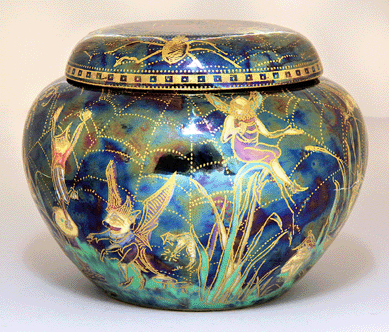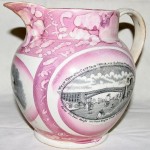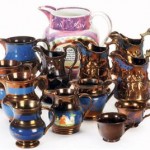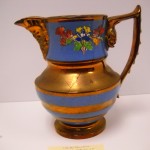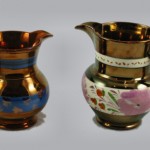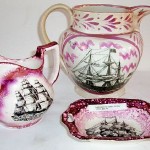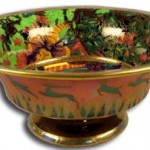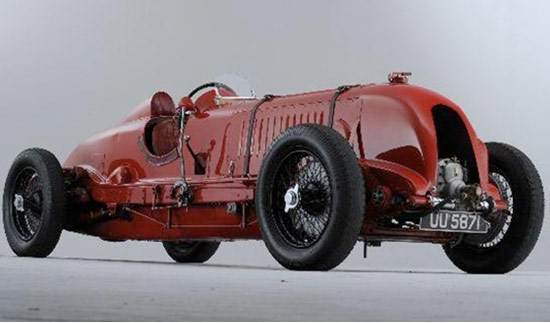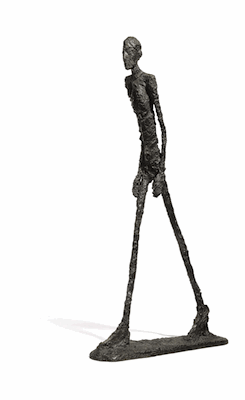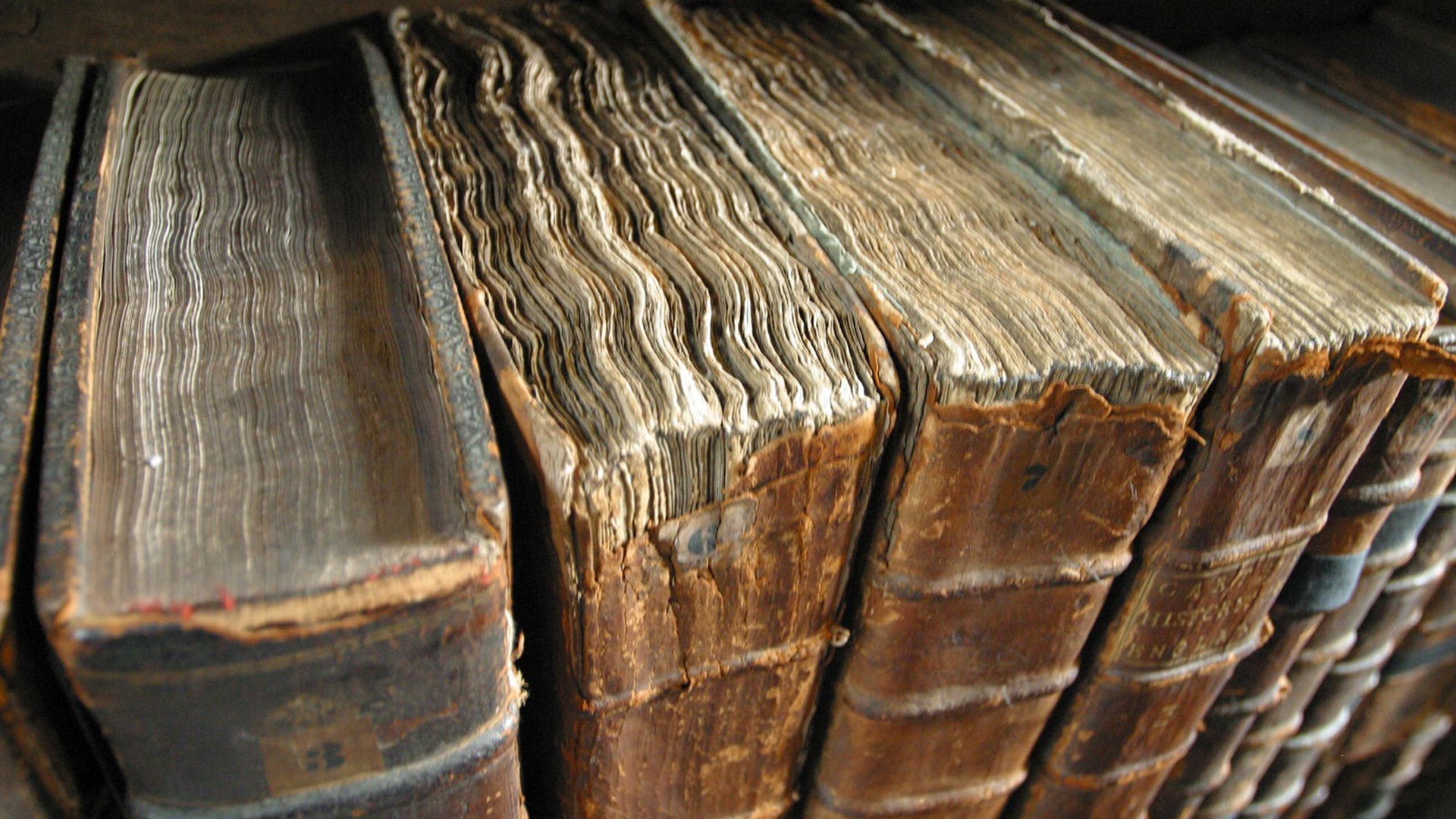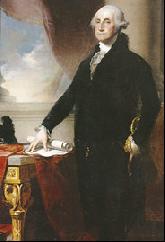Lusterware or Lustreware (respectively the US and all other English spellings) is a type of pottery or porcelain with a metallic glaze that gives the effect of iridescence, produced by metallic oxides in an overglaze finish, which is given a second firing at a lower temperature in a “muffle kiln”, reduction kiln, which excludes oxygen.
Many years ago when rooms were lit only by oil lamps and candles, people loved to have things around them that shone and glowed in this soft light.Wealthy people had their silver and glass, their burnished fire-dogs,their gilded furniture: but the less well off had to do it in other ways.One of these was by having lustred pottery and china on their shelves and mantlepieces reflecting the light from the fire into dark corners and recesses.
In England all sorts of pieces were made in lustre but the finest lustre ware was made in Italy and Spain in the fifteenth and sixteenth centuries
There are four principle classes of lustre ware: silver or platinum, copper or brown, gold, and pink or purple.
It was made by applying a metallic solution to the surface of a piece of pottery before the final firing. The metals gold, copper, and platinum were chemically dissolved and applied with a brush or by dipping. On account of the expensiveness of the metals used, the comparatively large surfaces covered, and the need for a low priced product, the solution was made very thin. The fact that the ware has stood the test of time so well is a proof of the excellence of the work and the effectiveness of the process. The body was generally a coarse earthenware, usually reddish, sometimes grayish in hue. Later a porcelain base was sometimes used.
Copper lustre was made as early as 1770 at Brislington, near Bristol, and prior to 1800 at Staffordshire, Longton, Sunderland (famous for its pink lustre), Leeds, Prestonpans, Dillwyn, Swansea, and at other potteries in different parts of England. It was also made in small quantities at Wedgwood’s Etruria works.
The earlier, cruder pieces are hard to place. More is known of the makers of the later ware, though very few pieces are marked. It is possible, too, that some of it was imported from Holland, Germany, Italy, Sweden, Denmark, and Belgium. Most is of English make.
Copper lustre, made with a copper solution, is the commonest, least artistic, and least valuable though by no means ugly or uninteresting. The appearance of the ware is that of burnished copper. The body is generally a coarse red earthenware, and many of the pieces are bad in shape and crude in workmanship. During its best period, however (about 1800), some very beautiful pieces were made, and these are well worth hunting for.
Copper lustre ware was made chiefly for everyday use, and much of it is plain or with a band or two of white or colour. Other pieces were decorated in relief, with the ornament in white, or coloured by hand in bright pigments on the copper ground.
About 1830 there came a second period of copper lustre manufacture, the products of which were inferior to the earlier, though not to be confused with modern imitations. The glaze on these second-period pieces is inferior, showing specks, pimples, holes, or bubbles, indicating haste and carelessness in manufacture. They were frequently ornamented with gaudy flowers, or banded in horizontal rings in blue, cream, or pink. These pieces are of small value to the collector. Both they and modern imitations (of which there are few in copper ) are to be distinguished from genuine old pieces by the depth and richness of colour, smoothness of glaze, and especially by weight. The modern ware is much heavier, and pieces that seem heavier than known genuine pieces should be avoided.
The most valuable piece of copper lustre is probably the Cornwallis jug. On one side is printed in a medallion a scene of the surrender at Yorktown, and on the other a portrait of Lafayette, flanked by emblematic figures holding a wreath. It is a large piece, excellent in shape. These jugs are now difficult to find and are rather valuable.
Silver lustre is not quite as old as copper, dating from about 1785, but is far superior in beauty and excellence of workmanship. In many respects it is the best of the English lustre ware, and in artistic quality it rivals the finest English china. It was made by a deposit of platinum on pottery or porcelain. The body was usually a reddish or buff earthenware of varying thickness. The tea- and coffee-pots were made thick to withstand heat, while some of the other pieces are as thin as porcelain. Wedgwood used a dark-red clay; a few potters used a dead white porcelain body, and others a yellowish, brownish, gray, or white clay.
The main purpose was to imitate solid silver for those who could not afford the precious metal. It was, therefore, lustred inside and out-especially tea-sets, bowls, and mugs. Later the outside only was lustred, the inside being given a white porcelain glaze. The lustre itself is brighter than the most highly burnished silver.
Some of the early pieces were excellent in lustre and shape but had no relief or ornamentation. Others were modelled on the body in fluted and pearl patterns, and the whole dipped in the platinum solution, producing brilliant high lights on the relief. Some of the ribbed or fluted tea-sets are called Oueen Anne, because they follow in a measure the ornamental style of the Queen Anne period, though of course made much later.
Later came the decorated silver, the ornamentation of which is often very beautiful. Jugs, tea-sets, etc., began to be made with bands of colour and with more or less elaborate patterns, sometimes in relief in white, and sometimes painted in silver on a white ground. Foliage, fruit, and birds were the commonest patterns, though a variety of others were used. Where the pattern was in silver the piece was first given a white glaze and the pattern was drawn very skilfully with a brush. In the relief pieces the silver was put on with a brush around the raised pattern.
Some of the silver lustre is marked, but most of it is not. It was made by many potters. Wedgwood the elder started to make it in 1791, but he died in 1795 and made very little; his sons made more.
The third group is gold lustre. Made in the same way by means of a thin deposit of gold on a dark pottery body. In the best pieces it shows the real light gold colour, though occasionally it shades off to a copper tone, and hence is sometimes confused with copper. It is very rare, but actual comparison of the gold and copper lustre will at once show the difference.
Gold is often very beautiful and very valuable. Very few pieces are to be found but there are a number of good pieces in private collections.
The term gold lustre is further confused by its occasional application to what is better known as pink, ruby, or purple. This includes the rosespotted and Sunderland. This was produced by applying a gold solution, which, in oxidizing, gave a pink or purplish tint. In a few cases the mixture was so fixed as to produce a brilliant gold sheen in the high lights and a ruby or purple colour elsewhere, thus adding further to the confusion of terms.
The genuine pink is easily distinguishable. It is less durable than the copper and silver, possibly because the gold was used sparingly and thinly spread.
Among the desirable pieces are cups and saucers of the best period (1790-1800) entirely covered with a soft rose-pink glaze.
Sunderland ware was a popular rose pink lustre, shading to purple, the colour applied in bands or wreaths, or covering the whole surface. Sailor jugs, Masonic jugs, and marriage jugs, bearing the names of bride and groom, were popular, ranging in size from a gill to a gallon.
One of the famous products of the Sunderland factories was the frog mug or jug. It bore the figure of a frog, life coloured, either crawling up the side or on the bottom of the inside, which was revealed when the mug was gradually emptied. Old frog mugs are extremely hard to find now. Another much sought for piece of Sunderland ware is a mug bearing a picture of the famous cast-iron bridge over the river Wear, which was completed in 1796.
Some of the Sunderland pieces bear the maker’s mark, such as the impressed “Fell,” or “Fell, Newcastle,” but so much of it does not that it is scarcely worth while making a study of the marks.
Violet or purple is very similar to the pink, except that a slight variation in the process gave it a purple or violet colour. Some of this was made at Swansea, but the bulk of it came from Newhall. This ware includes both hard and soft paste, chiefly a delicate white, decorated in black landscapes, hunting scenes, emblematic designs, etc., with bands of purple.
Two marks were used, a large impressed N is found on the earlier hard-paste ware. Later a thicker soft-paste printed ware was made, on which the name Newhall appears, printed in dull red or brown, surrounded by a double circle. Among the prints on Newhall ware are to be found the pictures “Mother and Child,” “Reclining Maiden,” “Children Playing with Each Other,” and fanciful pictures of women in Classic costumes playing with children, dogs, or birds.
Demand for English lustre ware is increasing and therefore becoming more valuable.

